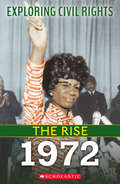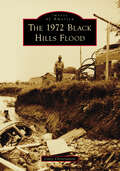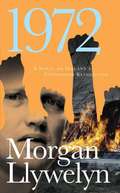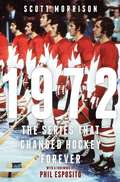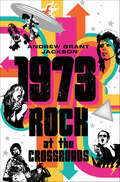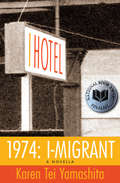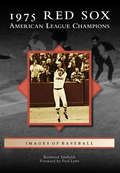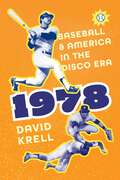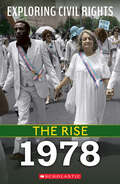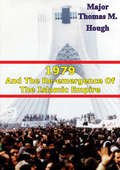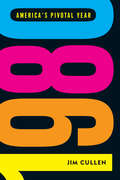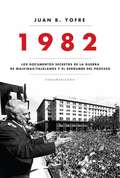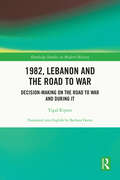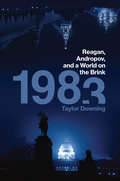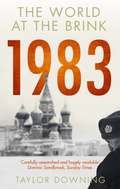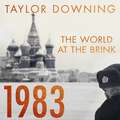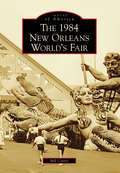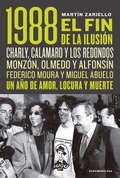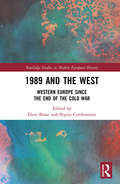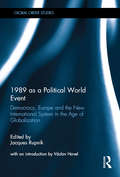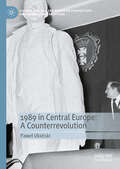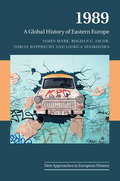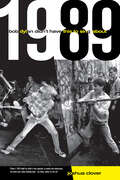- Table View
- List View
1971
by Srinath RaghavanThe war of 1971 was the most significant geopolitical event in the Indian subcontinent since its partition in 1947. At one swoop, it led to the creation of Bangladesh, and it tilted the balance of power between India and Pakistan steeply in favor of India. The Line of Control in Kashmir, the nuclearization of India and Pakistan, the conflicts in Siachen Glacier and Kargil, the insurgency in Kashmir, the political travails of Bangladesh--all can be traced back to the intense nine months in 1971. Against the grain of received wisdom, Srinath Raghavan contends that far from being a predestined event, the creation of Bangladesh was the product of conjuncture and contingency, choice and chance. The breakup of Pakistan and the emergence of Bangladesh can be understood only in a wider international context of the period: decolonization, the Cold War, and incipient globalization. In a narrative populated by the likes of Nixon, Kissinger, Zhou Enlai, Indira Gandhi, Zulfikar Ali Bhutto, Sheikh Mujibur Rahman, Tariq Ali, George Harrison, Ravi Shankar, and Bob Dylan, Raghavan vividly portrays the stellar international cast that shaped the origins and outcome of the Bangladesh crisis. This strikingly original history uses the example of 1971 to open a window to the nature of international humanitarian crises, their management, and their unintended outcomes.
1972 (Exploring Civil Rights)
by Selene CastrovillaLearn about the key events of the civil rights movement in the latest installment of this exciting and informative series.The year 1972 was one of major accomplishments in the civil rights movement. In January, Shirley Chisolm became an inspiration as the first African American to seek the presidential nomination of a major political party. In February, Wilt Chamberlain won the NBA title for the Los Angeles Lakers and was named the Most Valuable Player, securing his place as one of the most talented athletes in the history of sports. The National Black Political Convention was held in March with a crowd of ten thousand African Americans to discuss and advocate for Black communities that were in economic and social crisis across the country. And in November, Andrew Jackson Young Jr., of Georgia, and Barbara Jordan from Texas became the first African Americans in the twentieth century elected to Congress from the Deep South.This detailed account explains why 1972 was such a critical year in the civil rights movement.ABOUT THE SERIES:The years from 1967 to 1978 were critical to the civil rights movement. Resistance was often met with violence against Black Americans struggling to end discrimination and segregation. Yet the courage of those yearning for equal opportunities under the law continued to persevere and set the stage for even more progress in the coming decades. Discover how this specific time period brought about change and how it still affects us as a society today.With stunning photographs throughout and rich back matter, each book focuses on a specific year and chronologically follows the detailed events that occurred and the changes that took place.
1972 Black Hills Flood, The (Images of America)
by Corey ChristiansonOver 50 years have passed since the Black Hills flood swept through western South Dakota in 1972, leaving tragedy in its wake. This book explores the extent of the damage through images that highlight Rapid City, Keystone, and the surrounding Black Hills. Dignitaries, including Sen. George McGovern, visited the Black Hills in the aftermath; these visitors, along with the actions taken for recovery, make an appearance in the story. Today, the Black Hills are a tourist destination, with Mount Rushmore National Memorial, Crazy Horse Memorial, and Custer State Park being the most well-known attractions. /Corey Christianson has spent years researching the 1972 Black Hills flood. She was a part of the 50th commemoration of the flood, for which she, along with a team of talented individuals, created an award-winning exhibit about the flood and the recovery of the Black Hills. The images in this book are from the Rapid City Public Library, US Air Force, Keystone Area Historical Society, and other organizations that strive to remember, honor, and commemorate the flood. /
1972: A Novel of Ireland's Unfinished Revolution
by Morgan LlywelynThe story of Ireland from 1950-1972 through the eyes of a young newspaper photographer, son and grandson of Irish revolutionaries.
1972: The Series That Changed Hockey Forever
by Scott MorrisonThe legacy of the greatest hockey series ever played, fifty years later, with stories from the players that shed new light on those incredible games and times.&“Cournoyer has it on that wing. Here&’s a shot. Henderson made a wild stab for it and fell. Here&’s another shot. Right in front...they score! Henderson has scored for Canada!&” These immortal words, spoken to hockey fans around the world by the legendary broadcaster Foster Hewitt, capture the historic final-seconds goal scored by Paul Henderson that won the 1972 Summit Series against the Soviet Union. Hockey fans know the moment well, but the story of those amazing eight games has never been fully told—until now. The series was the first of its kind, and one of the most dramatic sporting showdowns in history. With the Soviets dominating international hockey, this series was meant to settle the debate, once and for all, of who owned the game. It was Canada&’s best against the Soviets for the first time. And in the shadow of the Cold War, this was about more than eight games of hockey. Expectations were high as the series began. This was supposed to be easy for Team Canada, but after the disappointing first four games on home ice with only one win, victory seemed out of reach. With the final four games in Moscow, Canada got a rare glimpse behind the iron curtain as the team, as well as three thousand raucous fans, arrived in the USSR. Amid the culture shock and strained relations, what followed was a tug-of-war battle that lasted to the dying seconds of game 8. Now, five decades after this historic event, it&’s time to reflect on the greatest hockey series ever played. Veteran journalist and hockey analyst Scott Morrison uses a storyteller&’s voice to reveal what it meant to hockey then, and what it means now. Filled with the memories of the players and others involved with the series, he shows how it changed the game, and challenged a nation&’s sense of identity and place in the world.
1973: Rock At The Crossroads
by Andrew Grant JacksonA fascinating account of the music and epic social change of 1973, a defining year for David Bowie, Bruce Springsteen, Pink Floyd, Elton John, the Rolling Stones, Eagles, Elvis Presley, and the former members of The Beatles. 1973 was the year rock hit its peak while splintering—just like the rest of the world. Ziggy Stardust travelled to America in David Bowie’s Aladdin Sane. The Dark Side of the Moon began its epic run on the Billboard charts, inspired by the madness of Pink Floyd's founder, while all four former Beatles scored top ten albums, two hitting #1. FM battled AM, and Motown battled Philly on the charts, as the era of protest soul gave way to disco, while DJ Kool Herc gave birth to hip hop in the Bronx. The glam rock of the New York Dolls and Alice Cooper split into glam metal and punk. Hippies and rednecks made peace in Austin thanks to Willie Nelson, while outlaw country, country rock, and Southern rock each pointed toward modern country. The Allman Brothers, Grateful Dead, and the Band played the largest rock concert to date at Watkins Glen. Led Zep’s Houses of the Holy reflected the rise of funk and reggae. The singer songwriter movement led by Bob Dylan, Neil Young, and Joni Mitchell flourished at the Troubadour and Max’s Kansas City, where Bruce Springsteen and Bob Marley shared bill. Elvis Presley’s Aloha from Hawaii via Satellite was NBC’s top-rated special of the year, while Elton John’s albums dominated the number one spot for two and a half months.Just as U.S. involvement in Vietnam drew to a close, Roe v. Wade ignited a new phase in the culture war. While the oil crisis imploded the American dream of endless prosperity, and Watergate’s walls closed in on Nixon, the music of 1973 both reflected a shattered world and brought us together.
1974: I-Migrant Hotel (I Hotel #7)
by Karen Tei Yamashita"I-Migrant" is the seventh novella of I Hotel, a National Book Award finalist and epic of America's struggle for civil rights as it played out in San Francisco's Chinatown. Yamashita's cast of students, laborers, artists, revolutionaries, and provocateurs make their way through the history of the day, caught in riptides of politics and passion, clashing ideologies and personal turmoil.
1975 Red Sox: American League Champions (Images of Baseball)
by Raymond Sinibaldi Fred LynnThe 1975 American League Champion Boston Red Sox squared off with the Cincinnati Reds in what is widely recognized as one of the best World Series ever played. The Major League Baseball Network has named its sixth game "the greatest game ever played." The Red Sox were led by two rookies, 21-year-old Jim Rice and 22-year-old Fred Lynn, who formed a rookie duo the likes of which baseball had never seen. They combined with a budding superstar in Carlton Fisk and his aging counterpart Carl Yastrzemski to lead the Red Sox attack, while a wily Luis Tiant anchored the pitching staff. After a first-round sweep of the three-time World Champion Oakland A's, they advanced to a Fall Classic that echoes through the ages, and in the words of Carlton Fisk, the Red Sox won "three games to four.
1978: Baseball and America in the Disco Era
by David KrellAmericans struggled to find their footing in the late 1970s. The Vietnam War ended with more than fifty-eight thousand American soldiers&’ deaths; the public&’s trust in politicians plummeted amid the Watergate scandal. As deadly blizzards ripped through the Midwest and Northeast in early 1978 and caused hundreds of millions of dollars in damages, Americans turned to baseball for the welcome distraction and promise of a new season. From spring training to the World Series, 1978 gave baseball fans one of the sport&’s greatest seasons, full of legendary moments like the battle between the New York Yankees and the Boston Red Sox for the American League East pennant, Gaylord Perry&’s three thousandth strikeout, Tom Seaver&’s only career no-hitter, Willie McCovey&’s five hundredth home run, and Pete Rose&’s marathon forty-four-game hitting streak. The 1978 season played out against a backdrop of disco music, bell-bottom pants, and gas-guzzling cars, while Hollywood answered a desperate longing for a simpler time with nostalgic offerings such as Grease, The Buddy Holly Story, American Hot Wax, Animal House, and Superman. Robin Williams became a household name with a guest appearance on the popular TV show Happy Days, Atlantic City debuted its first casino, and Jill Clayburgh symbolized the emerging independence of women in An Unmarried Woman. In a memorable end to the baseball season, Reggie Jackson and Bucky Dent led the Yankees to their second consecutive World Series over the Dodgers after losing the first two games, then winning four in a row. With a month-by-month approach, David Krell breaks down major events in both baseball and American culture at large in 1978, chronicling in novelistic detail the notable achievements of some of the greatest players of the era, along with some of the national pastime&’s quirkiest moments, to capture an extraordinary year in baseball.
1978: Exploring Civil Rights (Exploring Civil Rights)
by Nel YomtovLearn about the key events of the civil rights movement in the latest installment of this exciting and informative series.The year 1978 was one of steps toward equality in the civil rights movement. In February, Max Robinson successfully became the first African American broadcast network anchor for ABC news. In June, the Supreme Court case California v. Bakke ruled that affirmative action was legal in the United States and race could be included in the criteria for admissions into colleges and universities. In July, the National Organization of Women coordinated an impressive march of 100,000 demonstrators in Washington, DC, in support of the Equal Rights Amendment. And the world watched as African American boxer, Muhammad Ali, defeated Leon Spinks to win his third heavyweight title in September, becoming the first person to ever to win the title three times.This detailed account explains why 1978 was such a critical year in the civil rights movement.ABOUT THE SERIES:The years from 1967 to 1978 were critical to the civil rights movement. Resistance was often met with violence against Black Americans struggling to end discrimination and segregation. Yet the courage of those yearning for equal opportunities under the law continued to persevere and set the stage for even more progress in the coming decades. Discover how this specific time period brought about change and how it still affects us as a society today.With stunning photographs throughout and rich back matter, each book focuses on a specific year and chronologically follows the detailed events that occurred and the changes that took place.
1979 And The Re-Emergence Of The Islamic Empire
by Major Thomas M. HoughIn 1979 the age old struggle for the control of Islam between the Shiite and Sunni sects re-emerged in the Middle East. Four events occurred in 1979 that defined the context of contemporary Middle Eastern politics: the Islamic revolution in Iran, the signing of the Egyptian-Israeli peace accords, the siege of the Grand Mosque in Mecca, Saudi Arabia, and the Soviet invasion of Afghanistan. This monograph directly addresses the roots of current Middle Eastern actors such as HAMAS, FATA, Hezbollah, Al-Qaida, and the Taliban in the aftermath of these four critical events that occurred in 1979.The methodology for this monograph consists of analyzing each of these four events and then synthesizing this information in order to determine how 1979 shaped the modern Middle East. Since the seventeenth century the Sunni sect dominated Islam. The Iranian revolution reenergized the Shiite sect throughout the Middle East while Sunni power simultaneously eroded throughout the region. While the Shiites were inspiring the Islamic community in 1979, the Sunni suffered significant blows to their legitimacy as the leaders of Islam.This monograph asserts that the prevailing conflict within the Middle East is first and foremost a contest between the Shiites and the Sunni for preeminence within the Islamic world. The conflict between Islam and the outside world remains secondary in importance. The contemporary Middle Eastern actors that dominate the western consciousness such as HAMMAS, FATA, Hezbollah, Al-Qaida, and the Taliban constitute proxy armies created by the Shiite and Sunni leadership to wage a war for influence within the Islamic world. The events of 1979 have resulted in a leveling of power in the Middle East and the emergence of the Shiites as an ideological peer competitor to the traditionally dominant Sunni.
1980: America's Pivotal Year
by Jim Cullen1980 was a turning point in American history. When the year began, it was still very much the 1970s, with Jimmy Carter in the White House, a sluggish economy marked by high inflation, and the disco still riding the airwaves. When it ended, Ronald Reagan won the presidency in a landslide, inaugurating a rightward turn in American politics and culture. We still feel the effects of this tectonic shift today, as even subsequent Democratic administrations have offered neoliberal economic and social policies that owe more to Reagan than to FDR or LBJ. To understand what the American public was thinking during this pivotal year, we need to examine what they were reading, listening to, and watching. 1980: America's Pivotal Year puts the news events of the era—everything from the Iran hostage crisis to the rise of televangelism—into conversation with the year’s popular culture. Separate chapters focus on the movies, television shows, songs, and books that Americans were talking about that year, including both the biggest hits and some notable flops that failed to capture the shifting zeitgeist. As he looks at the events that had Americans glued to their screens, from the Miracle on Ice to the mystery of Who Shot J.R., cultural historian Jim Cullen garners surprising insights about how Americans’ attitudes were changing as they entered the 1980s. Praise for Jim Cullen's previous Rutgers University Press books: "Informed and perceptive" —Norman Lear on Those Were the Days: Why All in the Family Still Matters "Jim Cullen is one of the most acute cultural historians writing today." —Louis P. Masur, author of The Sum of Our Dreams on Martin Scorsese and the American Dream "This is a terrific book, fun and learned and provocative....Cullen provides an entertaining and thoughtful account of the ways that we remember and how this is influenced and directed by what we watch." —Jerome de Groot, author of Consuming History on From Memory to History
1982 (EBOOK)
by Juan B. YofreEl presidente militar argentino jamás imaginó que 1982 iba a convertirse, por la vía de la aventura de Malvinas, en el año que cambiaría para siempre la historia de las últimas décadas. Galtieri -lo mismo que el resto de la Junta Militar- pensaba que los ingleses jamás iban a mandar su flota, que los norteamericanos se alinearían con Buenos Aires, que las islas volverían a tener por siempre la bandera celeste y blanca y, básicamente, que la guerra de Malvinas le iba a garantizar a los militares gobernar el país hasta 1989. Se equivocó en todo. A través del análisis de un gran número de documentos reservados del Proceso (la totalidad de los papeles de la Cancillería y la "Memoria" realizada por la Junta Militar), 1982, el nuevo libro de Juan Bautista Yofre, revela la guerra y sus laberintos políticos y diplomáticos como jamás se habían mostrado. Su relato se basa en una tarea de investigación notable, para la que el autor no contó con ayuda oficial de ninguna índole. Yofre vuelve a trabajar sobre información "dura" para llegar a una serie de conclusiones que, a treinta años del conflicto, están llamadas a cambiar la perspectiva que hasta hoy se tenía acerca de Malvinas, sus causas y sus consecuencias. "Conozco a la Señora Thatcher y sé que es muy decidida, contestará todo acto de fuerza con más fuerza. (...) Le pediría a mi vicepresidente que viaje y trate de arreglar esta situación, pero por favor eviten el conflicto." Ronald Reagan "Le agradezco pero es tarde, los hechos están lanzados." Leopoldo Fortunato Galtieri
1982, Lebanon and the Road to War: Decision-Making on the Road to War and During It (Routledge Studies in Modern History)
by Yigal KipnisOn June 6, 1982, the Israeli Defence Forces entered Lebanon for what was billed as a relatively limited operation. In reality, the Lebanon War claimed many lives and undermined public trust in decision-makers. Through newly published archival documents, this book explores the events that led to the war and the actions of the people involved.With the help of documents published in this book for the first time, historian Yigal Kipnis lays out the circumstances of the war, the preparations and discussions leading up to and during it, Israel's convoluted moves against the administration in Washington and against the Lebanese Christians, and above all – the consistent coordination between Prime Minister Menachem Begin and Minister of Defense Ariel Sharon. The goals of the war were derived from Begin's worldview. Sharon worked to achieve these goals in the military field while Begin operated in the Israeli political field and diplomatically with the United States. To this end, he skillfully, cleverly, and decisively maneuvered between his principles and his obligations as a leader guiding a nation to war and to the political struggle for its justice. However, he was also subject to extreme emotional changes, as revealed by the detailed reports of his behavioral transformations by representatives of the US State Department.This book will be of interest to researchers of Middle Eastern political history, US-Israeli relations, and the Israeli-Palestinian conflict, as well as political science and political history.
1982: Los documentos secretos de la guerra de Malvinas/Falklands y el derrumbe del pro
by Juan B. YofreA través del análisis de documentos reservados, Yofre elabora una seriede conclusiones que cambian la perspectiva que se tenía acerca de laguerra de Malvinas, sus causas y sus consecuencias. El libro revela la guerra y sus laberintos políticos y diplomáticos comojamás se habían mostrado, a través del análisis de la totalidad de lospapeles de la Cancillería y la "Memoria" realizada por la Junta Militar.Su relato se basa en una tarea de investigación notable, para la que elautor no contó con ayuda oficial de ninguna índole.«Conozco a la Señora Thatcher y sé que es muy decidida, contestará todoacto de fuerza con más fuerza. (...) Le pediría a mi vicepresidente queviaje y trate de arreglar esta situación, pero por favor eviten elconflicto». Ronald Reagan«Le agradezco pero es tarde, los hechos están lanzados». LeopoldoFortunato GaltieriGaltieri jamás imaginó que 1982 iba a convertirse, por la vía de laaventura de Malvinas, en el año que cambiaría para siempre la historiade las últimas décadas. Pensaba que los ingleses jamás iban a mandar suflota, que los norteamericanos se alinearían con Buenos Aires, que las islas volverían a tener por siempre la bandera celeste y blanca y, básicamente, que la guerra de Malvinas le iba a garantizar a los militares gobernar el país hasta 1989. Se equivocó en todo.
1983: Reagan, Andropov, and a World on the Brink
by Taylor DowningA riveting, real-life thriller about 1983--the year tensions between the United States and the Soviet Union nearly brought the world to the point of nuclear ArmageddonThe year 1983 was an extremely dangerous one--more dangerous than 1962, the year of the Cuban Missile Crisis. In the United States, President Reagan vastly increased defense spending, described the Soviet Union as an "evil empire," and launched the "Star Wars" Strategic Defense Initiative to shield the country from incoming missiles. Seeing all this, Yuri Andropov, the paranoid Soviet leader, became convinced that the US really meant to attack the Soviet Union and he put the KGB on high alert, looking for signs of an imminent nuclear attack.When a Soviet plane shot down a Korean civilian jet, Reagan described it as "a crime against humanity." And Moscow grew increasingly concerned about America's language and behavior. Would they attack? The temperature rose fast. In November the West launched a wargame exercise, codenamed "Abel Archer," that looked to the Soviets like the real thing. With Andropov's finger inching ever closer to the nuclear button, the world was truly on the brink.This is an extraordinary and largely unknown Cold War story of spies and double agents, of missiles being readied, intelligence failures, misunderstandings, and the panic of world leaders. With access to hundreds of astonishing new documents, Taylor Downing tells for the first time the gripping but true story of how near the world came to nuclear war in 1983.
1983: The World at the Brink
by Taylor Downing'A carefully researched and hugely readable account of the build-up to war, the momentum inexorably growing as he assembles each part of the jigsaw. Indeed, his narrative is so persuasive that by the time you are about two- thirds through, it takes some effort to remind yourself that the Third World War never happened' Dominic Sandbrook, Sunday Times1983 was a supremely dangerous year - even more dangerous than 1962, the year of the Cuban Missile Crisis. In the US, President Reagan massively increased defence spending, described the Soviet Union as an 'evil empire' and announced his 'Star Wars' programme, calling for a shield in space to defend the US from incoming missiles.Yuri Andropov, the paranoid Soviet leader, saw all this as signs of American aggression and convinced himself that the US really meant to attack the Soviet Union. He put the KGB on alert to look for signs of an imminent nuclear attack. When a Soviet fighter jet shot down Korean Air Lines flight KAL 007 after straying off course over a sensitive Soviet military area, President Reagan described it as a 'terrorist act' and 'a crime against humanity'. The temperature was rising fast.Then at the height of the tension, NATO began a war game called Able Archer 83. In this exercise, NATO requested permission to use the codes to launch nuclear weapons. The nervous Soviets convinced themselves this was no exercise but the real thing.This is an extraordinary and largely unknown Cold War story of spies and double agents, of missiles being readied, of intelligence failures, misunderstandings and the panic of world leaders. With access to hundreds of extraordinary new documents just released in the US, Taylor Downing is able to tell for the first time the gripping but true story of how near the world came to the brink of nuclear war in 1983. 1983: The World at the Brink is a real-life thriller.
1983: The World at the Brink
by Taylor Downing1983 was a supremely dangerous year - even more dangerous than 1962, the year of the Cuban Missile Crisis. In the US, President Reagan massively increased defence spending, described the Soviet Union as an 'evil empire' and announced his 'Star Wars' programme, calling for a shield in space to defend the US from incoming missiles.Yuri Andropov, the paranoid Soviet leader, saw all this as signs of American aggression and convinced himself that the US really meant to attack the Soviet Union. He put the KGB on alert to look for signs of an imminent nuclear attack. When a Soviet fighter jet shot down Korean Air Lines flight KAL 007 after straying off course over a sensitive Soviet military area, President Reagan described it as a 'terrorist act' and 'a crime against humanity'. The temperature was rising fast.Then at the height of the tension, NATO began a war game called Able Archer 83. In this exercise, NATO requested permission to use the codes to launch nuclear weapons. The nervous Soviets convinced themselves this was no exercise but the real thing.This is an extraordinary and largely unknown Cold War story of spies and double agents, of missiles being readied, of intelligence failures, misunderstandings and the panic of world leaders. With access to hundreds of extraordinary new documents just released in the US, Taylor Downing is able to tell for the first time the gripping but true story of how near the world came to the brink of nuclear war in 1983.1983: The World at the Brink is a real-life thriller.
1984 New Orleans World's Fair, The (Images of America)
by Bill CotterIn 1984, the city of New Orleans hosted the last world's fair held in the United States. Conceived as part of an ambitious effort to revitalize a dilapidated section of the city and establish New Orleans as a year-round tourist destination, it took more than 12 years of political intrigue and design changes before the gates finally opened. Stretching 84 acres along the Mississippi River, the fair entertained more than seven million guests with a colorful collection of pavilions, rides, and restaurants during its six-month run. While most world's fairs lose money, the 1984 New Orleans World's Fair had the dubious distinction of going bankrupt and almost closing early. However, the $350-million investment did succeed in bringing new life to the area, which is now home to the city's convention center and a bustling arts district.
1988. El fin de la ilusión: Charly, Calamaro y los Redondos; Monzón, Olmedo, Asís y Alfonsín; Federico Moura y Miguel Abuelo. Un año de amor, locura y muerte.
by Martín ZarielloUna semblanza divertida y reflexiva sobre 1988, un año bisagra en el rock nacional y en la vida cultural, política y social del país. Martín Zariello pone su lupa pop en el paisaje agridulce de esa época. El año en que -recién acababa de irse de este mundo Luca- mueren Federico Moura y Miguel Abuelo, el primer gobierno del retorno democrático entra en crisis y con él, el sueño entero de una generación parece desvanecerse. Una semblanza divertida y reflexiva sobre 1988, un año bisagra en el rock nacional y en la vida cultural, política y social del país. Como un rompecabezas, piezas aparentemente inconexas con los rostros de Alfonsín, Charly García, Luis Alberto Spinetta, Carlos Monzón, Cerati, Los Redonditos, Fito Páez, Alberto Olmedo, Rico & Seineldín y hasta Ricardo Piglia y Jorge Asís forman la trama de un año que, a tres décadas, pide urgente una revisión que soslaye las trampas de la nostalgia. Martín Zariello pone su lupa pop en el paisaje agridulce de ese año bisagra. El año en que -recién acaba de morir Luca- mueren Federico Moura y Miguel Abuelo, el primer gobierno del retorno democrático entra en crisis y con él, el sueño entero de una generación parece desvanecerse. Los capítulos: Alfonsín Live on tour 88 - Maral 39 - Amnesty es un lugar del que nadie puede regresar - Hipótesis alrededor de una canción de Cacho Castaña - Argentinos pero simpáticos - Pelusón of Foucault - Todos los femicidios, el femicidio - Sida intelectual - Te tendrás que cuidar - Los años del "rock pobre" -El amor antes del amor - Spaguetti del rock - La vanguardia era así - El futuro ya llegó
1989 and the West: Western Europe since the End of the Cold War (Routledge Studies in Modern European History)
by Eleni Braat Pepijn CorduwenerBack in 1989, many anticipated that the end of the Cold War would usher in the ‘end of history’ characterized by the victory of democracy and capitalism. At the thirtieth anniversary of this momentous event, this book challenges this assumption. It studies the most recent era of contemporary European history in order to analyse the impact, consequences and legacy of the end of the Cold War for Western Europe. Bringing together leading scholars on the topic, the volume answers the question of how the end of the Cold War has affected Western Europe and reveals how it accelerated and reinforced processes that shaped the fragile (geo-)political and economic order of the continent today. In four thematic sections, the book analyses the changing position of Germany in Europe; studies the transformation of neoliberal capitalism; answers the question how Western Europe faced the geopolitical challenges after the Berlin Wall came down; and investigates the crisis of representative democracy. As such, the book provides a comprehensive and novel historical perspective on Europe since the late 1980s.
1989 as a Political World Event: Democracy, Europe and the New International System in the Age of Globalization (Global Order Studies)
by Jacques RupnikThis book is not about the events of 1989, but about 1989 as a world event. Starting with the fall of the Berlin Wall and the collapse of the Soviet bloc it examines the historical significance and the world brought about by 1989. When the Cold War ended in Europe it ushered in a world in which the international agenda is set outside Europe, in America or Asia. The book critically examines and moves beyond some of the conveniently simple paradigms proposed in the nineties, by leading political scientists such as Fukuyama and Huntington, to show how the events of 1989 meant different things to different parties. This was an anti-utopian revolution, a symbol of the possibility of non-violent transitions to democracy, which raised the hopes of world-wide democratic changes. Contributors show how 1989 can be seen as the founding moment of a globalized world, but equal attention should be given to the dispersion of its meanings and the exhaustion of some of its main trends associated with the post-1989 era. Europe was reunited, yet it is in crisis. Twenty years on, global markets have brought about a global financial crisis. The fall of the Berlin Wall was celebrated as the advent of free movement in a world without borders. Now however, we can see that new borders, walls, fences have since been built. With an introductory essay by Vaclav Havel, 1989 as a Political World Event will be of interest to scholars of European Politics and International Relations.
1989 in Central Europe: A Counterrevolution (Central and Eastern European Perspectives on International Relations)
by Paweł UkielskiThe literature on the fall of communism contains numerous interpretations of the changes that took place in Central and Eastern Europe in 1989, while debates about how best to characterize the fall of the communist regimes have raged for many years. Researchers continue to ponder and argue over how ‘revolutionary’, as opposed to ‘evolutionary’ (or ‘reformatory’) these changes were. In this new study, author Paweł Ukielski proposes the term ‘counterrevolution’ to describe the historical process that took place and uses it as an analytical construct to better understand the crisis of Soviet communism and the subsequent transitions that took place.
1989: A Global History of Eastern Europe (New Approaches to European History #59)
by Tobias Rupprecht Ljubica Spaskovska James Mark Bogdan C. IacobThe collapse of the Berlin Wall has come to represent the entry of an isolated region onto the global stage. On the contrary, this study argues that communist states had in fact long been shapers of an interconnecting world, with '1989' instead marking a choice by local elites about the form that globalisation should take. Published to coincide with the thirtieth anniversary of the 1989 revolutions, this work draws on material from local archives to international institutions to explore the place of Eastern Europe in the emergence, since the 1970s, of a new world order that combined neoliberal economics and liberal democracy with increasingly bordered civilisational, racial and religious identities. An original and wide-ranging history, it explores the importance of the region's links to the West, East Asia, Africa, and Latin America in this global transformation, reclaiming the era's other visions such as socialist democracy or authoritarian modernisation which had been lost in triumphalist histories of market liberalism.
1989: Bob Dylan Didn't Have This to Sing About
by Joshua CloverIn a tour de force of lyrical theory, Joshua Clover boldly reimagines how we understand both pop music and its social context in a vibrant exploration of a year famously described as "the end of history." Amid the historic overturnings of 1989, including the fall of the Berlin Wall, pop music also experienced striking changes. Vividly conjuring cultural sensations and events, Clover tracks the emergence of seemingly disconnected phenomena--from grunge to acid house to gangsta rap--asking if "perhaps pop had been biding its time until 1989 came along to make sense of its sensibility." His analysis deftly moves among varied artists and genres including Public Enemy, N.W.A., Dr. Dre, De La Soul, The KLF, Nine Inch Nails, Nirvana, U2, Jesus Jones, the Scorpions, George Michael, Madonna, Roxette, and others. This elegantly written work, deliberately mirroring history as dialectical and ongoing, summons forth a new understanding of how "history had come out to meet pop as something more than a fairytale, or something less. A truth, a way of being."

